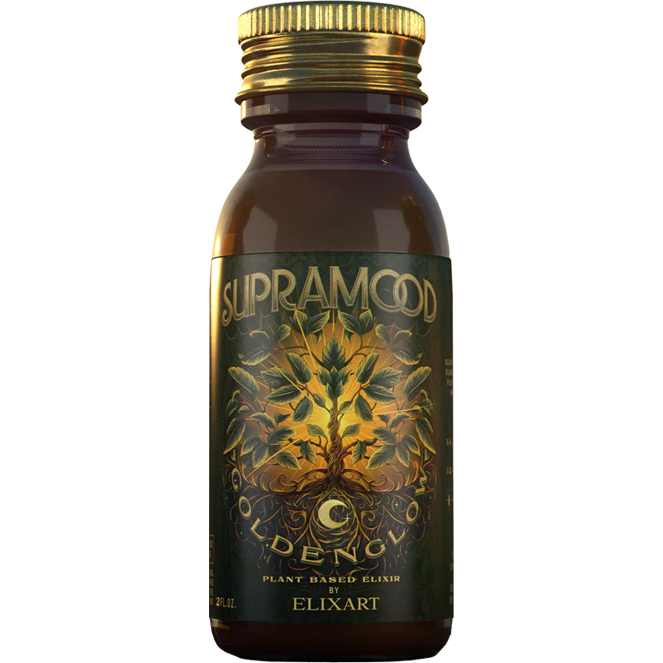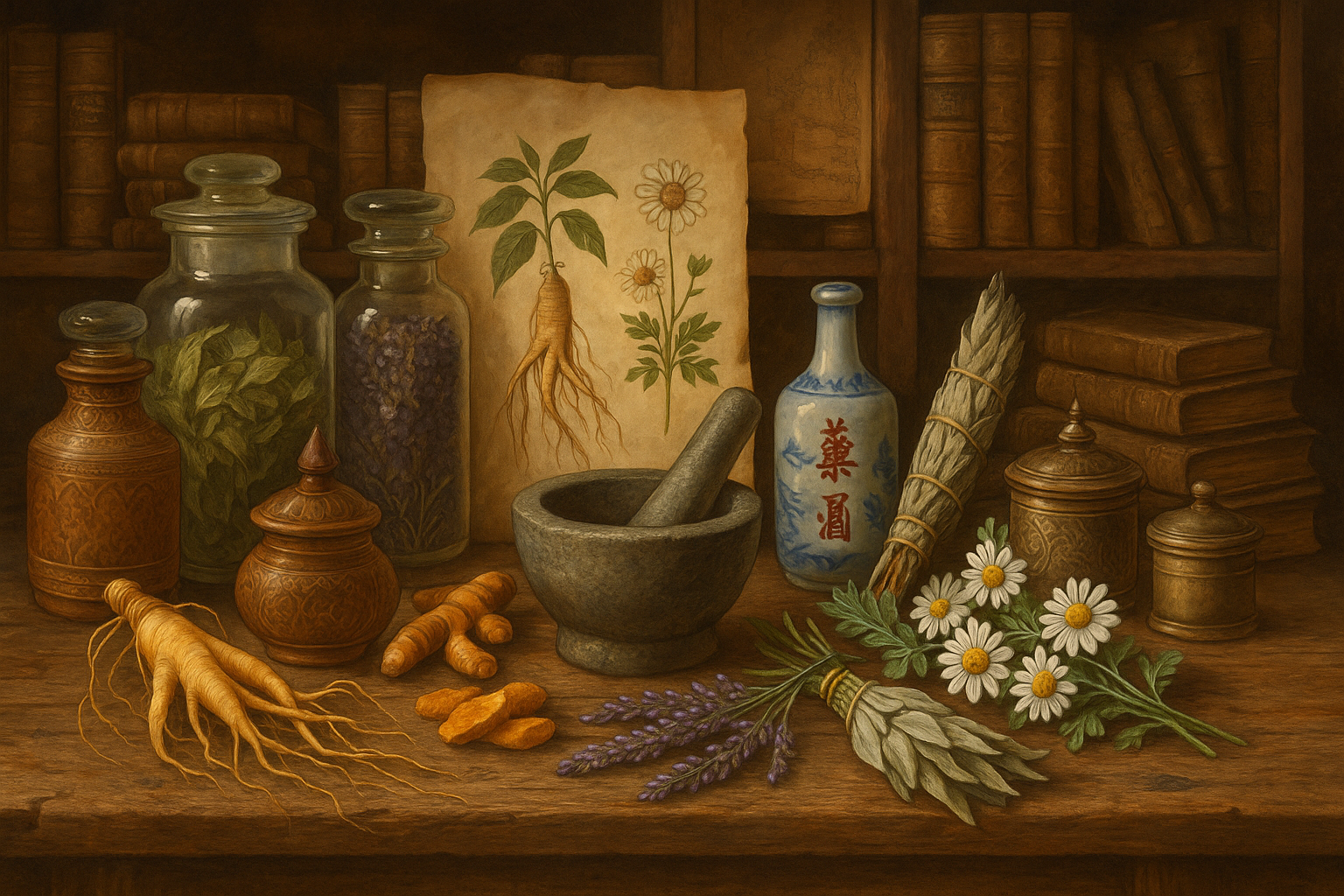Herbal healing has been used for centuries in traditional medicine to treat various ailments. Traditional Chinese Medicine (TCM) is particularly known for its holistic approach to health, using a wide range of herbs with therapeutic properties.
In recent years, there has been a renewed interest in herbal healing. More and more people are seeking out these natural remedies as alternatives or supplements to conventional treatments. However, despite this growing popularity, there is still much that scientists don't understand about how these herbal remedies actually work on a molecular level.
Key Takeaway: This article explores the scientific basis of herbal healing. We will examine the different ways in which these natural remedies interact with the body's molecular pathways, providing insights into their mechanisms of action.
1. Traditional Chinese Medicine (TCM) Approach to Herbal Healing
Traditional Chinese Medicine (TCM) has a long history of using herbal formulations to treat various ailments. With the increasing integration of TCM into modern healthcare, understanding herb-drug interactions is crucial for ensuring safe and effective treatment outcomes.
Herb-Drug Interactions in TCM
Potential for Interactions
Herbs used in TCM can interact with conventional medications through several mechanisms:
- Pharmacokinetic interactions: These occur when herbs affect the absorption, distribution, metabolism, or excretion of drugs. For instance, St. John's Wort can induce cytochrome P450 enzymes, leading to decreased plasma concentrations of certain medications like immunosuppressants and anticoagulants.
- Pharmacodynamic interactions: Herbs may also influence the pharmacological effects of drugs without altering their concentrations. Ginkgo biloba, for example, has blood-thinning properties that could enhance the effects of anticoagulant drugs, increasing the risk of bleeding.
Examples of Specific Herb-Drug Interactions
- Ginseng and Warfarin: Ginseng might decrease the effectiveness of warfarin by accelerating its metabolism.
- Licorice and Corticosteroids: Licorice can potentiate the effects of corticosteroids by inhibiting their breakdown, potentially leading to increased side effects.
- Ephedra and Stimulants: Ephedra contains ephedrine, which can synergize with other stimulants like caffeine to cause excessive cardiovascular stimulation.
Need for Caution
Combining herbal treatments with conventional medications requires careful consideration:
- Patient Education: Inform patients about potential interactions between their prescribed medications and any herbal products they are using.
- Healthcare Provider Awareness: Clinicians should be knowledgeable about common herb-drug interactions to provide informed guidance.
- Monitoring and Adjusting Dosages: Regular monitoring of drug levels and patient responses is essential when herbs are introduced into a treatment regimen.
Herb-Other Interactions: Food, Microbiome, and More
In addition to drug interactions, herbs in TCM formulations can interact with dietary components and the gut microbiome:
- Food Interactions: Certain foods can either enhance or inhibit the absorption and efficacy of herbal compounds. For instance, consuming citrus fruits may increase the bioavailability of some flavonoids found in herbs.
- Microbiome Modulation: The gut microbiome plays a significant role in metabolizing herbal compounds. Probiotics or prebiotics might alter this metabolism, impacting the therapeutic outcomes.
Herb-Disease Interactions: Bridging Traditional Knowledge with Modern Science
TCM practitioners consider individual patient characteristics and specific health conditions when prescribing herbal treatments:
- Personalized Medicine: Unlike conventional medicine's often one-size-fits-all approach, TCM tailors treatments based on unique patient profiles and disease patterns.
- Mechanisms of Action: Traditional theories provide a framework for understanding how herbs work at a molecular level. For example, ginseng is believed to tonify Qi (vital energy), which modern research correlates with its ability to modulate immune responses.
Understanding these complex interactions between herbs, drugs, food components, microbiome constituents, and disease states is vital for integrating TCM into contemporary medical practice safely. This holistic perspective ensures that patients receive comprehensive care tailored to their unique needs.
Herb-Other Interactions: Food, Microbiome, and More
Traditional Chinese Medicine (TCM) takes a holistic approach to healthcare. One of the main practices in TCM is using herbal remedies, often made with multiple herbs for better results. Understanding how these herbs interact with other factors is crucial to maximize their effectiveness.
Herb-Food Interactions
- Herbs in TCM can interact with the food we eat.
- Certain foods may enhance or diminish the efficacy of herbal compounds in our bodies.
- For instance, combining turmeric with black pepper can significantly improve curcumin absorption, the active compound in turmeric.
Herb-Microbiome Interactions
- The gut microbiome, which comprises various bacteria in our digestive system, plays a pivotal role in processing herbal compounds.
- Herbal ingredients can modulate the composition of gut bacteria, thereby influencing the effects of these herbs.
- Notably, ginseng has been observed to induce changes in gut bacteria composition, potentially contributing to its anti-inflammatory properties.
Synergistic Effects
- In TCM formulas, combining different herbs aims to create treatments that synergistically address multiple bodily systems at once.
- These combinations have been shown to have significant impacts on overall well-being and health outcomes according to studies such as "The Synergistic Effects of Herbal Combinations".
Herb-Disease Interactions: Bridging Traditional Knowledge with Modern Science
Traditional Chinese Medicine (TCM) takes a whole-body approach to healthcare, focusing on balance and harmony. A key part of TCM is using herbal remedies, which often have multiple herbs mixed together. The goal of these combinations is to create synergistic effects, where the herbs work together to improve treatment outcomes and minimize side effects.
When TCM practitioners prescribe herbal treatments, they carefully consider each patient's unique characteristics and specific health conditions. This personalized approach ensures that the herbal mix is tailored to the individual's specific needs. Here are some factors that may be taken into account:
- Patient age: Younger patients might receive different herbal mixes compared to older individuals because their bodies process things differently.
- Health status: Chronic conditions like diabetes or hypertension can affect which herbs are used to avoid any negative interactions.
In TCM, herbal formulas are created based on traditional concepts such as Qi, Yin-Yang balance, and the Five Elements. These ideas help guide the selection of herbs to target specific symptoms and underlying imbalances in the body. For example, a formula designed for respiratory issues may combine herbs known for their anti-inflammatory and immune-boosting properties.
It's important to understand how these herbs interact with each other. TCM's use of multi-herb formulas highlights the need to study herb-disease interactions at a molecular level. This research helps connect traditional knowledge with modern science, giving us a better understanding of how these natural remedies work against different diseases.
2. Exploring Molecular Pathways: Metabolomics and Beyond
Impact on Cellular Metabolism: Case Study in Glucose Regulation
Studying the inner workings of herbal remedies gives us fascinating information about how our cells process energy. One area of particular interest is glucose metabolism, which plays a crucial role in conditions like diabetes. It turns out that certain herbs have the potential to make a significant impact in this area.
How Herbal Compounds Influence Glucose Regulation
When it comes to glucose regulation, there are specific enzymes and signaling pathways that come into play. Herbal compounds have been found to affect these key players, leading to better control over blood sugar levels. Let's take a closer look at one example:
Berberine: A Versatile Compound
Berberine is a natural compound found in various plants such as Berberis aristata and Coptis chinensis. Research has shown that berberine can influence glucose metabolism through multiple mechanisms:
- Activation of AMP-activated protein kinase (AMPK): This enzyme is responsible for maintaining energy balance within our cells. By enhancing its activity, berberine helps increase glucose uptake and improve insulin sensitivity.
- Inhibition of gluconeogenesis: Berberine has the ability to suppress glucose production in the liver by blocking specific enzymes involved in this process.
- Improvement of insulin receptor function: Insulin receptors play a crucial role in allowing cells to take up glucose from the bloodstream. Berberine has been found to enhance their expression and activity, making it easier for cells to respond to insulin signals.
Ginseng: A Traditional Herb with Modern Benefits
Ginseng (Panax ginseng) is another herb that shows promise in regulating glucose levels. Its active components, known as ginsenosides, have been found to:
- Enhance insulin secretion: By stimulating the cells in our pancreas that produce insulin, ginsenosides help increase its release into the bloodstream.
- Promote glucose uptake by muscles: One of the key players in this process is a protein called GLUT4. Ginseng has been found to facilitate the movement of GLUT4 to the surface of muscle cells, allowing for greater absorption of glucose.
These examples highlight the complex ways in which herbs can influence glucose metabolism. Rather than relying on a single target, they work on multiple fronts simultaneously, offering a more holistic approach to managing diabetes.
The Power of Metabolomics: Uncovering Hidden Changes
To fully grasp the impact of herbal treatments on metabolic health, scientists have turned to a cutting-edge field known as metabolomics. This technique involves analyzing all the small molecules (metabolites) present within a biological system, such as cells or tissues.
Through metabolomics studies, researchers have made some interesting discoveries about how berberine affects our metabolism:
- It leads to changes in various metabolites associated with carbohydrate and lipid metabolism.
- These alterations provide us with a deeper understanding of how berberine works holistically to improve metabolic health.
By combining traditional knowledge with modern scientific tools like metabolomics, we're able to gain new insights into the therapeutic potential of herbs. This interdisciplinary approach opens up exciting possibilities for developing more effective treatments for metabolic disorders like diabetes.
Influence on Lipid Metabolism and Cardiovascular Health
Exploring the molecular mechanisms underlying herbal healing reveals significant impacts on lipid metabolism. Herbal compounds influence key aspects of lipid synthesis, transport, and oxidation pathways. This modulation plays a crucial role in managing cardiovascular diseases.
1. Lipid Synthesis
Certain herbs, such as Curcuma longa (turmeric), contain bioactive compounds like curcumin that inhibit enzymes involved in fatty acid synthesis. This reduction in lipid production can help manage hyperlipidemia and associated conditions.
2. Lipid Transport
Herbs like Ginkgo biloba impact lipid transport by altering the expression of proteins involved in cholesterol transport, such as apolipoproteins. This adjustment can reduce arterial plaque formation, lowering the risk of atherosclerosis.
3. Lipid Oxidation
Herbal extracts from Camellia sinensis (green tea) have been shown to enhance fatty acid oxidation through the activation of AMP-activated protein kinase (AMPK). Improved lipid oxidation helps maintain healthy blood lipid levels and supports cardiovascular health.
Advanced technologies like metabolomics enable a deeper understanding of these interactions at a systemic level. By analyzing metabolic profiles, researchers can identify specific pathways influenced by herbal treatments, offering insights into their therapeutic potential for cardiovascular health.
Evaluating the effects of herbal compounds on lipid metabolism highlights their promising role in cardiovascular disease management. Integrating these insights with modern therapeutic approaches can lead to more effective treatment strategies.
3. Targeting Signaling Pathways for Therapeutic Outcomes
The PI3K/AKT pathway plays a crucial role in controlling cell survival, growth, and metabolism. It is believed that many traditional herbs work by affecting this pathway to produce their therapeutic effects.
Understanding the PI3K/AKT Pathway
Here are some key roles of the PI3K/AKT pathway:
- Cell Survival and Growth: This pathway has control over essential cellular processes. When activated, it can support cell survival and division, making it an attractive target for cancer treatments.
- Therapeutic Actions of Herbs: Certain herbs have been found to influence the PI3K/AKT pathway. For example, Curcuma longa (turmeric) contains curcumin, which has been shown to block the PI3K/AKT pathway and potentially cause programmed cell death in cancer cells.
- Anti-inflammatory Effects: Many herbal compounds possess anti-inflammatory properties by affecting this signaling pathway. Glycyrrhiza glabra (licorice), for instance, can reduce inflammation by suppressing the PI3K/AKT pathway, offering relief in inflammatory conditions.
By understanding how herbs interact with these important molecular pathways, we can explore new possibilities for developing targeted treatments. Combining this knowledge with traditional healing practices holds great potential in addressing various health issues using a blend of modern science and ancient wisdom.
4. From Lab to Clinic: Potential Applications in Cancer Treatment
Exploring the potential of herbal medicines in cancer therapy has opened new avenues for developing innovative treatments. Many natural products, such as curcumin from turmeric and resveratrol from grapes, have shown promise as adjuvant therapies or lead compounds for novel cancer drugs. These compounds can modulate various molecular pathways involved in cancer progression.
Advantages of Herbal Combinations
- Multi-target approach: Herbal combinations can simultaneously target multiple signaling pathways, potentially increasing therapeutic efficacy and reducing the likelihood of drug resistance.
- Synergy: The combined effects of different herbs may enhance overall anticancer activity, providing a broader spectrum of action against different cancer types.
Challenges to Consider
- Standardization: Ensuring consistent quality and potency of herbal preparations remains a significant hurdle.
- Complex interactions: Understanding the complex interactions between multiple active constituents poses challenges for clinical application.
Herbal medicines offer unique advantages by targeting multiple pathways, which could provide more comprehensive treatment strategies compared to single-target agents. However, rigorous research and standardization are essential to translate these benefits from lab to clinic effectively.
5. Overcoming Hurdles: Ensuring Efficacy, Safety, and Quality of Herbal Products
Ensuring the effectiveness, safety, and quality of herbal products is crucial for them to be accepted in mainstream healthcare. There are several important steps that need to be taken:
Preclinical Evaluation and Clinical Trials
- Rigorous preclinical evaluation and clinical trials are essential steps. These trials help validate the anticancer potential of herbal products, drawing parallels with the regulatory process for conventional medications like FDA-approved anticancer drugs.
Standardized Manufacturing Practices
- Standardized manufacturing practices are another critical component. Consistency in production processes ensures that each batch of an herbal product meets the required standards. Key measures include:
- Good Manufacturing Practices (GMP): Adherence to GMP ensures that herbal products are consistently produced and controlled according to quality standards.
- Quality Control: Implementing stringent quality control measures helps detect any deviations from standard specifications. This includes testing for contaminants, verifying ingredient potency, and ensuring accurate labeling.
- These practices not only ensure safety but also build consumer trust. Without these standards, variability in herbal preparations can lead to inconsistent therapeutic outcomes or potential harm.
Bridging Traditional Practices with Modern Healthcare
- A robust regulatory framework similar to that of FDA-approved drugs can bridge the gap between traditional practices and modern healthcare, ensuring that herbal remedies are both safe and effective for patient use.
"Quality is never an accident; it is always the result of intelligent effort." – John Ruskin
6. Future Perspectives: Integrating Herbal Medicine and Conventional Care
As the field of medicine continues to evolve, there is increasing interest in exploring the potential benefits of combining herbal medicine with conventional treatments. This integration could lead to a more comprehensive approach to patient care, addressing both the underlying causes of disease and the management of symptoms.
Understanding the Power of Combination Therapies
Research suggests that combining herbal medicine with modern therapeutics could result in synergistic interactions, where the combined effect is greater than the sum of its parts. This concept opens up new possibilities for treatment, offering potential benefits such as:
- Enhanced Efficacy: By targeting multiple biological pathways simultaneously, the use of herbal compounds alongside conventional drugs may lead to improved treatment outcomes.
- Reduced Side Effects: Herbal remedies have been found to possess properties that can help mitigate the adverse effects associated with certain conventional treatments, making them a valuable addition to existing therapies.
- Personalized Medicine: Integrating herbal medicine into mainstream healthcare allows for more tailored treatment plans, taking into account individual patient profiles and specific health conditions.
Exploring Applications Through Case Studies
Cancer Treatment
One area where combination therapies are being extensively studied is in cancer treatment. Researchers are investigating the potential of certain herbal compounds, such as curcumin and resveratrol, to enhance the effectiveness of chemotherapy while reducing its toxicity[^1^][^2^].
Diabetes Management
In the realm of diabetes management, herbs like berberine have shown promise in regulating glucose levels when used alongside standard antidiabetic medications[^3^].
Overcoming Challenges for Integration
While there is excitement surrounding the integration of herbal medicine and conventional care, several challenges need to be addressed before widespread adoption can occur:
- Standardization: Ensuring the consistency and quality of herbal products is crucial for their effective integration into mainstream healthcare.
- Regulatory Hurdles: Navigating the complex regulatory landscape to gain approval for combined therapies requires rigorous scientific validation and evidence.
- Education and Awareness: Both healthcare providers and patients need education on the safe and effective use of integrated treatment plans.
The Road Ahead
The seamless integration of herbal medicine into conventional care holds promise for advancing drug discovery and offering more holistic healthcare solutions. By fostering collaboration between traditional wisdom and modern science, we can unlock new possibilities in patient care and pave the way for a future where the best of both worlds are combined.
Conclusion
Investing in further research into the complex mechanisms of herbal healing is essential. Understanding these mechanisms of action not only validates the therapeutic potential of herbal medicines but also promotes their integration into mainstream healthcare. By bridging traditional knowledge with modern scientific methods, we can unlock new avenues for personalized and sustainable treatment options.
Herbal medicine holds promise for driving a paradigm shift in healthcare. Its ability to provide personalized care tailored to individual patient needs, coupled with its sustainable nature, positions it as a valuable complement to conventional treatments. Embracing both the wisdom of traditional practices and the rigor of scientific validation can lead to more holistic and effective healthcare solutions.
Encouraging continued exploration and investment in this field will pave the way for evidence-based herbal medicines to become a cornerstone of future medical practices.
FAQs (Frequently Asked Questions)
What is the traditional Chinese medicine (TCM) approach to herbal healing?
The traditional Chinese medicine (TCM) approach to herbal healing involves the use of TCM formulas, which often combine multiple herbs for synergistic effects. It is important to study the interactions between these ingredients, as well as their potential interactions with conventional medications, food, and the gut microbiome.
How do certain herbs impact cellular metabolism, specifically in glucose regulation and lipid metabolism?
Certain herbs have been found to modulate key enzymes and signaling pathways involved in glucose metabolism, offering potential benefits for diabetes management. Additionally, herbal compounds can influence lipid synthesis, transport, and oxidation pathways, with implications for cardiovascular health.
What role do signaling pathways play in mediating the therapeutic actions of certain herbs?
Certain herbs have been found to target specific signaling pathways, such as the PI3K/AKT pathway, which is a key regulator of cell survival and growth. Understanding these mechanisms can provide insights into the therapeutic outcomes of herbal treatments.
How are herbal medicines being investigated for potential applications in cancer treatment?
Herbal medicines and their active constituents are being investigated as adjuvant therapies or lead compounds for developing novel cancer drugs. Researchers are comparing the advantages and challenges of targeting multiple signaling pathways with herbal combinations versus single-target agents in cancer treatment strategies.
What measures are being taken to ensure efficacy, safety, and quality of herbal products?
Rigorous preclinical evaluation and clinical trials are being conducted to validate the anticancer potential of herbal products. Additionally, standardized manufacturing practices and quality control measures are being implemented to ensure consistency and safety of herbal preparations.
What are the future perspectives on integrating herbal medicine and conventional care?
There is potential for synergistic interactions between herbal medicine and modern therapeutics, such as combination therapies that target both upstream molecular pathways and downstream symptom relief. This integration could lead to more personalized and sustainable healthcare approaches.







Leave a comment
This site is protected by hCaptcha and the hCaptcha Privacy Policy and Terms of Service apply.